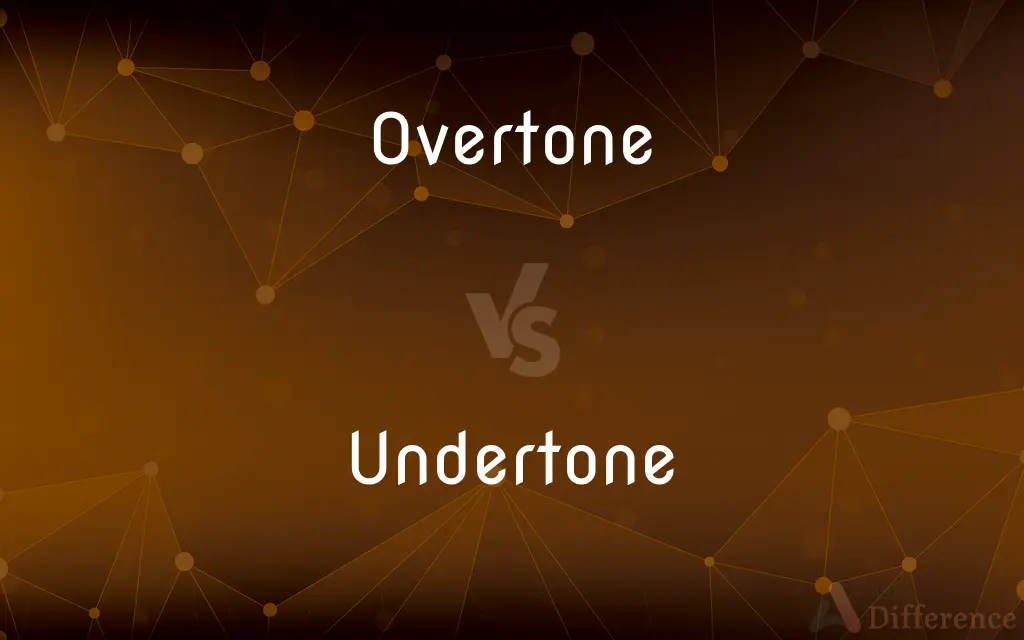Overtone vs. Undertone — What's the Difference?
By Urooj Arif & Maham Liaqat — Updated on March 26, 2024
An overtone is a higher frequency harmonic of a fundamental tone, enriching sound quality, while an undertone refers to a subdued or implied quality, often in speech or color.

Difference Between Overtone and Undertone
Table of Contents
ADVERTISEMENT
Key Differences
Overtone refers to the harmonic frequencies that are higher than the fundamental frequency of a sound, contributing to the timbre or color of the sound heard. These harmonics are integral to the richness and complexity of musical tones. On the other hand, undertone implies a subtle or underlying quality or feeling, often suggesting something not explicitly stated but perceived, whether in speech, literature, or visual arts.
In music, overtones are crucial for distinguishing different types of sounds or musical instruments playing the same note, as each instrument produces a unique set of overtones. Whereas, undertones can be used to describe the subtle hues beneath the surface color in art, or the implied messages and emotions in communication, revealing depth beyond the overt expression.
The concept of overtones is primarily used in the field of acoustics and music theory, focusing on the physical properties of sound and how they are perceived by the ear. Undertones, however, find broader application across various disciplines, including literature, art, and psychology, emphasizing the nuances and complexities of expression and perception.
While overtones add to the physical perception of sound, enriching and defining it, undertones contribute to the psychological or emotional perception, offering depth and subtext to spoken words, visual imagery, or narrative. This distinction highlights how overtones and undertones enrich experiences in different sensory and cognitive domains.
Despite their different applications, both overtones and undertones enhance the depth and complexity of our experiences. Overtones do so by adding layers to our auditory experiences, while undertones provide a layer of meaning or emotion that resonates on a more subconscious level.
ADVERTISEMENT
Comparison Chart
Definition
Higher frequency harmonic of a fundamental tone
Subdued or implied quality, often in speech or color
Domain
Acoustics, music theory
Literature, art, psychology, communication
Contribution
Enriches sound quality by adding harmonics
Adds depth and nuance through subtle qualities or implications
Perception
Physical (auditory experience)
Psychological/emotional (subtext, implied meaning)
Application
Distinguishing musical instruments, understanding sound timbre
Conveying subtle messages, underlying emotions, or color nuances
Compare with Definitions
Overtone
Produced by vibrating bodies, like strings or air columns.
The overtone patterns in a guitar note add to its richness.
Undertone
Found in the nuanced subtext of communication.
His speech carried an undertone of urgency despite his calm demeanor.
Overtone
Integral to sound quality and timbre.
Singers practicing overtone singing to achieve a unique sound effect.
Undertone
Reflects underlying emotions or themes.
The dialogue in the play had a humorous undertone that lightened the mood.
Overtone
Can be selectively amplified to alter sound.
Adjusting a synthesizer’s settings can emphasize certain overtones.
Undertone
A subtle or implied quality not overtly expressed.
The undertone of melancholy in the painting enhanced its depth.
Overtone
A harmonic frequency above the fundamental tone, enriching sound.
The overtone series of a violin string creates its distinctive timbre.
Undertone
Can denote subdued hues or qualities in art.
The portrait’s warm undertones gave it a lifelike appearance.
Overtone
Distinguishes instruments playing the same note.
The piano and flute sound different due to their overtone profiles.
Undertone
Influences perception and interpretation.
The novel’s undertones of rebellion resonate with readers.
Overtone
An overtone is any frequency greater than the fundamental frequency of a sound. In other words, overtones are higher pitches resulting from the lowest note or fundamental.
Undertone
An underlying or implied tendency or meaning; an undercurrent.
Overtone
An ulterior, usually implicit meaning or quality; an implication or a hint
An overtone of anger barely masked.
Praise with overtones of envy.
Undertone
A tone of low pitch or volume, especially of spoken sound.
Overtone
See harmonic.
Undertone
A pale or subdued color.
Overtone
A tone whose frequency is an integer multiple of another; a member of the harmonic series.
Undertone
A color applied under or seen through another color.
Overtone
An implicit message (in a film, book, verbal discussion or similar) perceived as overwhelming the explicit message.
Undertone
An auditory tone of low pitch or volume.
Overtone
(transitive) To give an overtone to.
Undertone
An implicit message perceived subtly alongside, but not detracting noticeably from, the explicit message conveyed in or by a book, film, verbal dialogue or similar (contrast with overtone); an undercurrent.
Overtone
One of the harmonics faintly heard with and at a higher frequency than a fundamental tone as it dies away, produced by some aliquot portion of the vibrating sting or column of air which yields the fundamental tone; one of the natural harmonic scale of tones, as the octave, twelfth, fifteenth, etc.; an aliquot or "partial" tone; a harmonic. See Harmonic, and Tone.
Undertone
A pale colour, or one seen underneath another colour.
Overtone
(usually plural) an ulterior implicit meaning or quality;
Overtones of despair
Undertone
A low state of the physical faculties.
Overtone
A harmonic with a frequency that is a multiple of the fundamental frequency
Undertone
To accompany as an undertone.
Undertone
To say or speak in an undertone.
Undertone
To present as less important, noticeable or prominent.
Undertone
A low or subdued tone or utterance; a tone less loud than usual.
Undertone
A quiet or hushed tone of voice;
Spoke in undertones
Undertone
Subdued emotional quality underlying an utterance; implicit meaning
Undertone
A pale or subdued color
Common Curiosities
Can overtones change the quality of a musical instrument?
Yes, the specific overtones produced can significantly affect the perceived quality and character of a musical instrument’s sound.
Is it possible to isolate an overtone in music?
Isolating an overtone can be challenging in practice, but certain techniques, like overtone singing, can emphasize specific overtones.
Can the undertone of a story change its interpretation?
Yes, the undertone of a story can significantly influence how it is interpreted, highlighting underlying messages or themes.
What role do undertones play in literature?
In literature, undertones provide depth and subtlety, allowing authors to convey complex themes and emotions indirectly.
Do overtones contribute to the uniqueness of a singer’s voice?
Yes, the unique blend of overtones in a singer’s voice contributes to their distinctive sound.
How do undertones affect communication?
Undertones affect communication by adding depth, implying emotions or intentions that are not explicitly stated.
What distinguishes an overtone from a note played on an instrument?
An overtone is a natural harmonic frequency of a note, whereas the note itself is determined by the fundamental frequency played.
What are overtones in music?
Overtones in music are higher frequency harmonics that accompany a fundamental tone, contributing to the sound’s timbre and richness.
Are overtones audible?
Yes, overtones are audible and contribute to the overall perception of a sound’s timbre and character.
How do undertones contribute to the mood of a painting?
Undertones can subtly influence a painting’s mood, adding emotional depth or tension through color hues and shading.
Can everyone perceive undertones in speech?
While most people can perceive undertones in speech, the ability to interpret them accurately can vary based on individual sensitivity and context.
How are overtones produced in musical instruments?
Overtones are produced by the natural vibrations of a musical instrument’s sound-producing elements, like strings or air columns.
How can understanding undertones improve communication skills?
Recognizing and employing undertones can enhance communication by allowing for more nuanced and emotionally resonant messages.
What is the significance of overtones in acoustics?
In acoustics, overtones help explain the complex nature of sound production and perception, contributing to our understanding of sound quality and timbre.
Why are undertones important in visual art?
Undertones add complexity and emotional depth to visual art, influencing the viewer’s perception and emotional response.
Share Your Discovery

Previous Comparison
Cricket vs. Football
Next Comparison
Claspt vs. ClaspAuthor Spotlight
Written by
Urooj ArifUrooj is a skilled content writer at Ask Difference, known for her exceptional ability to simplify complex topics into engaging and informative content. With a passion for research and a flair for clear, concise writing, she consistently delivers articles that resonate with our diverse audience.
Co-written by
Maham Liaqat













































